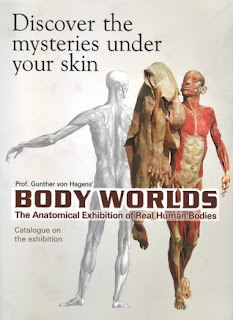Week 4: Medicine + Technology + Art
The medical
fields, particularly human anatomy, have always fascinated artists.
Understanding human body structure components such as the skeleton and muscles
is an essential skill for many art students. One modern example of how art and
medicine intertwine is the BODY WORLDS exhibit, a touring art gallery that
features perfectly preserved human organs and bodies. This special exhibition
is in fact the product of a long history of medical technology. Specifically,
Gunther von Hagens’s plastination technique (discovered in 1979) made it
possible to preserve biological tissue specimen using polymer mixtures. This
type of art reflects on society’s changing perceptions of human anatomy. From
analyzing individual cadavers to creating databases on systems of microbial organisms
in the body, medical technology continues to inspire revolutionary pieces of
art (Vesna, 2012).
(The book cover of Gunther Von Hagens's Body Worlds Catalog, first published in 2006.)
Popular
culture suggests a growing fascination with the ever-evolving medical field.
For example, TV shows such as “Nip/Tuck” and “House” accurately portray
surgical procedures in hospitals. Personally, I admire the technical skill and
dexterity that is apparent in each episode. What I didn’t realize was the
artistic aspect of medical technology. While analyzing X-ray images and solving
exaggerated patient cases, the doctors exude a sense of creativity in their
work.
(Picture from the TV show, House, which features advanced medical technology and even more challenging patient illnesses.)
Personally—and
fortunately—I have not experienced the interface of art and current medical
technology, such as prosthetic limbs and implanted RFID chips. I am, however,
aware of the growing trend in cosmetic surgeries. Also known as plastic
surgery, these procedures can be perceived as expressions of body performance
art, as pioneered by French artist Orlan in the 1970s (Vesna, 2012). These
procedures are perfect examples of how medicine, technology, and art intersect.
Medical technology is growing and being applied to suit new standards of
beauty. Korea is known for its plastic surgery technology, so the figure below
suggests how European and Asian standards influence this phenomenon.
(Comparison of plastic surgery technology and standards of beauty in America and Korea)
The fascination with medicine and
technology will only grow, and I look forward to seeing how anatomical art
projects transform!
References:
Vesna, Victoria. Medicine
pt1. Online video clip. YouTube.
YouTube, 21 Apr. 2012. Web. 30 Apr. 2017.
Vesna, Victoria. Medicine
pt2. Online video clip. YouTube.
YouTube, 21 Apr. 2012. Web. 30 Apr. 2017.
Vesna, Victoria. Medicine
pt3. Online video clip. YouTube.
YouTube, 22 Apr. 2012. Web. 30 Apr. 2017.
Image sources:
Plastic Surgery in Korea. “Plastic Surgery in America vs.
Korea.” Digital Image. Seoul TouchUp. www.seoultouchup.com, n.d. Web. 30 Apr.
2017.
Hagens, Gunther Von. “Body Worlds The Original Exhibition of
Real Human Bodies – Catalog.” Digital Image. Web. 30 Apr. 2017.
House – Season 1 Promo. Digital image. Pinterest, n.d. Web.
30 Apr. 2017.



Comments
Post a Comment